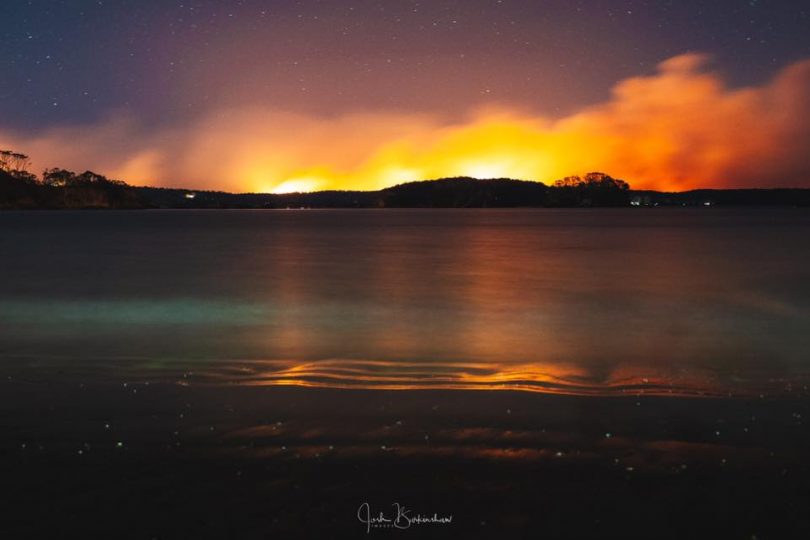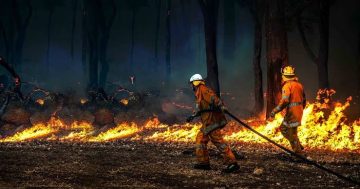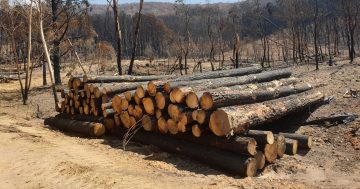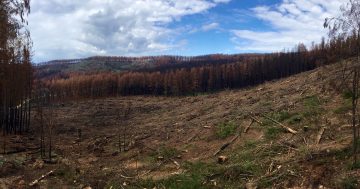
The Currowan bushfire as seen from Batemans Bay on 5 December, 2019. Photo: Josh Burkinshaw Images.
After burning for 74 days, the Currowan bushfire had killed three people, damaged or destroyed hundreds of homes and burnt half a million hectares.
More than four months after the fire was officially declared extinguished, the “bushfire bomb” of logging waste in the Benandarah State Forest remains put, a decision which has been described as “braindead” and “tone deaf” by a local community group.
“During the [bushfires] the logging waste in Benandarah State Forest was a bushfire bomb,” Alec Marr from Friends of Durras told Region Media. “Logging slash no doubt exacerbated the intensity of the fire near Mogo.
“More than 100 tonnes per hectare of logging waste on the ground sitting there drying out and everybody thought that if fire hit, places such as Durras, Long Beach and Benandarah [would be destroyed].”
The Friends of Durras group has heavily criticised the forestry industry for how it managed its operations before the past summer’s bushfires.
“Loggers target big old trees and those mature forests tend to hold water longer than anywhere else so they are much harder to burn than young regrowth,” said Mr Marr.
“A good example is what happened around Mogo. They went in there and cut down all the mature forests, left a whole lot of logging debris on the ground and then what was left there was regrowth which burns much more easily.”
The Forestry Corporation of NSW, which runs logging operations in the Benandarah State Forest, denies that its actions leave forests more fire prone.
“Scientific consensus does not support a link between timber harvesting and fire risk,” a spokesperson told Region Media.
“The same forests have been continually harvested and regrown for more than a century. The prevailing conditions this season, combining extreme drought and fire weather, made fires uncontrollable across all types of forest, grassland and cleared paddocks.
“Recently harvested forest comprised a very small fraction of the area affected by fires this season.”

Alec Marr, from the Friends of Durras community group, wants logging slash removed mechanically to reduce bushfire risk. Photo: Supplied.
The Forestry Corporation of NSW also claims it took proactive steps to help mitigate bushfire risk both before and after the past summer’s bushfire season.
“Under the firewood collection permit system, permits were issued to community members for close to 500 tonnes of firewood from Benandarah State Forest this year … which significantly reduced fuel loads,” said the spokesperson.
“Forestry Corporation, working with the Rural Fire Service, also constructed fire breaks and back burns to prevent fire running into the harvesting slash during the fire season.”
However, the CEO of Forestry Corporation of NSW, Nick Roberts, has been heavily criticised by both Friends of Durras, and NSW Liberal MP Andrew Constance, who previously called Mr Roberts’s silence on the issue “deafening”.
“These people are not just tone-deaf, they are brain dead,” said Mr Marr. “It was an absolutely stupid logging operation in the first place. What we wanted was that to be cleaned up mechanically [to reduce fire-prone regrowth].
“They let in a few people for free firewood. That does nothing; that is just some public relations garbage. They did not log that area for free firewood.
“Give me a single practice from the forestry industry that has changed as a result of these fires. The answer is nothing.”
Mr Marr’s castigation of the Forestry Corporation comes during the same week the bushfire royal commission – formally titled the Royal Commission into National Natural Disaster Arrangements – is examining hazard reduction and the administration and practice of fuel load management.
On Monday, 17 June, the Royal Commission heard that some forms of hazard reduction, including prescribed burns, actually make forests more susceptible to bushfires in the future.
“Depending on how well those operations were carried out, in five or 10 years’ time you may actually end up with a worse fuel arrangement if the way in which the regeneration occurs brings back more flammable species,” said Associate Professor Kevin Tolhurst.
Hazard reduction burning is an essential part of the Forestry Corporation’s bushfire management program, it says.
In May 2019, the Forestry Corporation said it planned to conduct 10,000 hectares of hazard reduction burns in NSW South Coast state forests to “reduce the intensity and severity of wildfires, and protect communities and the environment”.
In June 2019, it carried out a strategic hazard reduction burn in another part of Benandarah State Forest to protect Batemans Bay. It is currently conducting a hazard reduction burn in Benandarah.

Firefighters battling the Currowan blaze on the Princes Highway. Photo: Austinmer Rural Fire Service.
However, Mr Marr said the practice is too close to communities and that is what puts them in danger of more intense bushfires. In his submission to the bushfire royal commission, he has called for an end to logging within 30km of a town or village.
“To build resistance to drought and fire we have to let our forests reach their biological potential,” he said.
The Forestry Corporation says it complies with all relevant laws and authorities before conducting its operations.
“There are strict conditions regulating forestry in NSW, which were developed with the input of expert scientific panels to protect and maintain wildlife habitat, forest flora, water quality and biodiversity across the landscape,” said the spokesperson.
“Forestry Corporation operates in line with relevant licenses and regulations which are independently regulated by the Environment Protection Authority.”
Original Article published by Dominic Giannini on The RiotACT.













